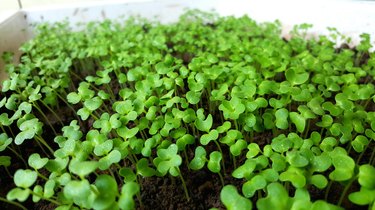
Clover (Trifolium spp.) is an iconic plant often associated with superstition, luck, and for being so adorable. It's also called a nitrogen-fixing plant because it hosts bacteria in nodules on its roots that yield nitrogen that nearby plants can use. When clover dies, this nitrogen becomes useful to a lot of nearby vegetables and flowers. Because it is so beneficial to surrounding vegetation, clover is often called "green manure." It also has other uses and can be a cover plant for many gardens and is sometimes also planted in the place of turfgrass. It is sown depending on its designated use.
General Planting Time
Video of the Day
Plant clover in the spring when frost is past and the temperature is 40 degrees Fahrenheit or warmer at night. The best time to plant clover in the spring is from mid-April to mid-May to coincide with spring rains. Clover also needs from four to six hours of sunlight daily. If you are able to irrigate, seed clover in late summer to early autumn. If you plant it then, do it at least six weeks before the first heavy frost. If freezing temperatures are rare in your climate, you can plan it any time in the winter. Dutch white clover (Trifolium repens) is a perennial in U.S. Department of Agriculture plant hardiness zones 3 through 10, and red clover (Trifolium pratense) is a perennial in zones 3 through 9.
Video of the Day
Planting as Garden Cover
As a living mulch, clover not only contributes nitrogen to the soil, it helps keep weeds at bay and holds moisture in the soil. If you plant clover between rows of vegetables, sow it one-third of the way through the growing cycle of the vegetables. If the clover is already growing, dig rows in it for pole beans or dig holes for broccoli, tomatoes, eggplants or other tall-growing vegetables.
Planting as Turf
Dutch white clover is sometimes mixed with grass seed for lawns in spring planting because it will grow in areas that are too shady or poorly drained for conventional grass species. Clover spreads rapidly, crowding out broadleaf weeds that appear in lawns, plus it resists drought, remaining green in dry, hot summer weather. This spreading quality give some annual species invasive qualities, which cause them to be considered as weeds. These include the narrow-leaved clover (Trifolium angustifolium), shamrock clover (Trifolium dubium), knotted clover (Trifolium striatum) and subterranean clover (Trifolium subterraneum).
Clover Planting Basics
Clover needs soil with a pH between 6 to 7. If the pH is low, try using lime or limestone to the soil. It can be found in any home and gardening store. If the soil is too acidic, try mixing in elemental sulfur to raise the pH.
Spread 2 ounces of tiny clover seeds on top of 1,000 square feet. Mixing the seeds with sand makes them easier to spread. Rake the seeds lightly into the soil and rake no more than 1/4 inch deep. Water newly sown seeds occasionally to keep the soil moist. When temperatures are warm, clover seeds will germinate in seven to 15 days. Clover grows from 6 to 8 inches tall. If you mix clover seeds with lawn grass seeds, they should be 5 to 10 percent of the total seed weight. There is no need to fertilize.
- Sustainable Agriculture Research & Education: White Clover
- National Gardening Association: Fall Garden Cover Crop
- USDA, National Resources Conservation Service: White Clover, Trifolium Repens
- Organic Gardening: Cover Crop Basics
- Mother Earth News: Grow Cover Crops for Best Garden Soil
- Old Farmer’s Almanac: Clover Comeback
- Outside Pride: Clover Seed Planting Instructions